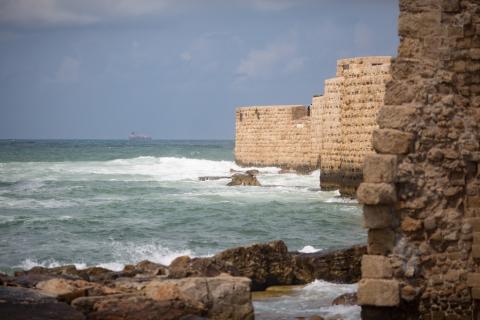‘Abdu’l-Bahá, the true Exemplar of the teachings of Bahá’u’lláh demonstrated this form of detachment by His actions. Throughout His life, He never wished to exalt His name nor did He seek publicity for Himself. For instance, He had an immense dislike of being photographed. He said '... to have a picture of oneself is to emphasize the personality... During the first few days of His visit to London, He refused to be photographed. However, as a result of much pressure by the newspaper reporters, and persistent pleas by the friends to take His photograph, ‘Abdu’l-Bahá acquiesced in order to make them happy.
Abdu’l-Bahá - portrait
Mrs. Gibbons, a Bahá’í, had written the Master before His coming to the United States, requesting that her own daughter be allowed to paint His portrait. In His reply He consented to this request and added, according to Mrs. Gibbons, that Juliet Thompson would paint a portrait of Him. Juliet Thompson had long dreamed that she would paint the face of Christ.
During the month of June, ‘Abdu’l-Bahá allowed Juliet Thompson to paint His portrait telling her to paint His “Servitude to God”. She completed it over the course of six sittings which took place over multiple days in different rooms. Juliet remembered that fourth sitting on June 19th because of an extraordinary experience she and Lua Getsinger had on that day.
As the Master prepared to sit for the portrait, He turned to Lua Getsinger who was also in the room and told her in Persian that these sittings made Him sleepy. He sat down and closed His eyes. Juliet studied Him but found that she could not begin painting because ‘Abdu’l-Bahá’s countenance reflected the dignity and peace of the Divine Realm.
Then, as though awakened by the Holy Spirit, ‘Abdu’l-Bahá opened His eyes and with great power said:
"I appoint you, Lua, the Herald of the Covenant. And I AM THE COVENANT, appointed by Bahá’u’lláh. And no one can refute His Word. This is the Testament of Bahá’u’lláh. You will find it in the Holy Book of Aqdas. Go forth and proclaim, 'This is THE COVENANT OF GOD in your midst.'"
A great joy seemed to fill Lua while Juliet wept at witnessing this extraordinary moment of spiritual force flowing through the Master. Then ‘Abdu’l-Bahá became quiet again. The Holy Spirit receded, and ‘Abdu’l-Bahá the man re-emerged. He smiled at Juliet and told her that she must stop crying since she would not be able to paint through tears.
In the afternoon of that same day He sent Lua Getsinger downstairs to speak about the Covenant to the visitors waiting there. When He went down later, He read from Bahá’u’lláh’s Tablet of the Branch and spoke with great power on the Covenant. ‘Abdu’l-Bahá designated New York City, the “City of the Covenant”.
Later that day, Juliet Thompson was working on ‘Abdu’l-Bahá's portrait while Lua Getsinger watched. Juliet recorded what happened next: "I had just begun to work, Lua in the room sitting on a couch nearby, when the Master smiled at me; then turning to Lua said in Persian: "This makes me sleepy what shall I do?" "Tell the Master, Lua, that if He would like to take a nap, I can work while He sleeps. But I found that I could not. What I saw then was too sacred, to formidable. He Sat still as a statue, his eyes closed, infinite peace on that chiseled face, a Godlike calm and grandeur in his erect head.
On 1 June, Juliet Thompson went to the Master to begin painting His portrait. When she arrived He asked, "Can you paint Me in a half hour?" "A half-hour, my Lord?" I stammered, appalled. "I can never finish a head in less than two weeks." "Well, I will give you 3 half hours. You mustn't waste My time Juliet." He told me to come to Him Saturday morning, June 1, at 7:30. I went in a panic. He was waiting for me in the entrance hall, a small space in the English basement where the light not much of it comes from the South. In fact, I found myself faced with every kind of handicap. I always paint standing, but now I was obliged to sit, so close to the window (because of the lack of distance between the Master and me), that I couldn't even lean back. No light. No room. And I had brought a canvas for a life-size head. The Master was seated in a dark corner, His black 'abá melting into the background; and again, I saw Him as the Face of God, and quailed. How could I paint the Face of God? "I want you", He said, "to paint my servitude to God." "Oh my Lord", I cried, "only the Holy Spirit could paint Your servitude to God. No human hand could do it. Pray for me, or I am lost. I implore you, inspire me." "I will pray", He answered, "and as you are doing this only for the sake of God, you will be inspired." And then, an amazing thing happened. All fear fell away from me and it was as though Someone Else saw through my eyes. Worked through my hand. All the points, all the planes in that matchless face were so clear to me that my hand couldn't put them down quickly enough, couldn't keep pace with the clarity of my vision. I painted in ecstasy, free as I had never been before. At the end of the half-hour the foundation of the head was perfect.
